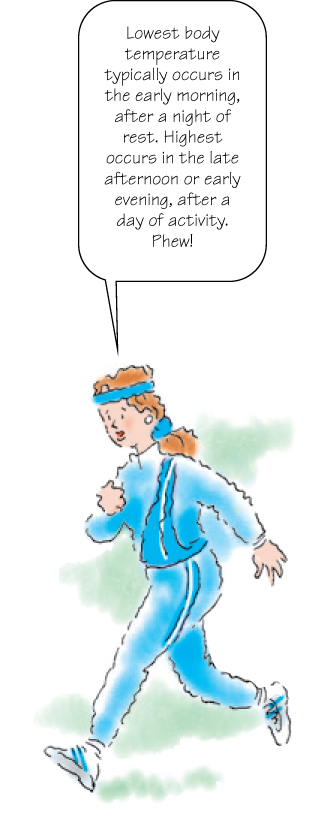Body temperature represents the balance between heat that metabolism, muscular activity, and other factors produce and heat that's lost through the skin, lungs, and body wastes. A stable temperature pattern promotes proper function of cells, tissues, and organs; a change in this pattern may signal the onset of illness.
Temperature can be measured with one of two types of thermometers: electronic digital (includes temporal artery and tympanic thermometers) or chemical-dot. Oral temperature in adults normally ranges from 97° to 99.5° F (36.1° to 37.5° C). Rectal temperature, the most accurate reading, is usually 1° F (0.6° C) higher. Axillary temperature, the least accurate reading, is usually 1° to 2° F (0.6° to 1.1° C) lower. Tympanic temperature reads 0.5° to 1° F higher. (See Types of thermometers.) Temperature changes outside the usual range are related to changes in heat loss or production.
Temperature is controlled by the hypothalamus. Temperature normally fluctuates with rest and activity (circadian rhythm). Lowest readings typically occur between 1 and 4 a.m. and the highest readings between 4 and 8 p.m. Other factors also influence temperature. (See Differences in temperature.)
Electronic thermometer, chemical-dot thermometer, temporal artery thermometer, or tympanic thermometer  water-soluble lubricant or petroleum jelly (for rectal temperature)
water-soluble lubricant or petroleum jelly (for rectal temperature)  facial tissue
facial tissue  disposable thermometer sheath or probe cover (except for chemical-dot thermometer)
disposable thermometer sheath or probe cover (except for chemical-dot thermometer)  alcohol pad
alcohol pad  gloves (for rectal temperature).
gloves (for rectal temperature).
Identify the patient with two identifiers per facility policy.
Perform hand hygiene.
Explain the procedure to the patient. If you're taking an oral temperature and the patient had hot or cold liquids, chewed gum, or smoked, wait 15 minutes before getting started.

With an electronic thermometer
Insert the probe into a disposable probe cover. If taking a rectal temperature, lubricate the probe cover to reduce friction and ease insertion. Leave the probe in place until the maximum temperature appears on the digital display. Then remove the probe and note the temperature.

With a chemical-dot thermometer
Remove the thermometer from its protective case by grasping the handle end with your thumb and forefinger, moving the handle up and down to break the seal, and pulling the handle straight out. Leave the chemical-dot thermometer in place for 45 seconds.
Read the temperature as the last dye dot that has changed color, or fired, then discard the thermometer and its dispenser case.
With a tympanic thermometer
Make sure the lens under the probe is clean and shiny. Attach a disposable probe cover.
Stabilize the patient's head, then gently pull his ear straight back (for children up to age 1) or up and back (for children age 1 and older to adults).
Insert the thermometer until the entire ear canal is sealed. The thermometer should be inserted toward the tympanic membrane in the same way that an otoscope is inserted.
Press the activation button and hold it for 1 second. The temperature will appear on the display. (See Taking an infant's temperature.)
Put on gloves and position the tip of the thermometer under the patient's tongue on either side of the frenulum as far back as possible. Placing the tip in this area promotes contact with superficial blood vessels and ensures a more accurate reading.
Instruct the patient to close his lips but to not bite down with his teeth to avoid breaking the thermometer in his mouth.
Leave the thermometer in place for the appropriate length of time, depending on which thermometer was used.
Position the patient on his side with his top leg flexed and drape him to provide privacy. Then fold back the bed linens to expose his anus.
Squeeze the lubricant onto a facial tissue to avoid contaminating the lubricant supply.
Lubricate about ½'' (1 cm) of the thermometer tip for an infant, 1'' (2.5 cm) for a child, and 1½'' (3.8 cm) for an adult to reduce friction and ease insertion. This step may be unnecessary when using disposable rectal sheaths because they're prelubricated.
Put on gloves, lift the patient's upper buttock, and insert the thermometer about ½'' (1 cm) for an infant and 1½'' (3.8 cm) for an adult.
Gently direct the thermometer along the rectal wall toward the umbilicus to avoid perforating the anus or rectum or breaking the thermometer and to help ensure an accurate reading. (The thermometer will register hemorrhoidal artery temperature instead of fecal temperature.)
Hold the thermometer in place for the appropriate length of time to prevent damage to rectal tissues caused by displacement.
Carefully remove the thermometer, wiping it as necessary. Then wipe the patient's anal area to remove any lubricant or feces.
Remove your gloves and wash your hands.
Position the patient with the axilla exposed.
Put on gloves and gently pat the axilla dry with a facial tissue because moisture conducts heat. Avoid harsh rubbing, which generates heat.
Ask the patient to reach across his chest and grasp his opposite shoulder, lifting his elbow.
Position the thermometer in the center of the axilla, with the tip pointing toward the patient's head.
Tell him to keep grasping his shoulder and to lower his elbow and hold it against his chest to promote skin contact with the thermometer.
Leave the thermometer in place for the appropriate length of time, depending on which thermometer you're using. Axillary temperature takes longer to register than oral or rectal temperature because the thermometer isn't enclosed in a body cavity.
Grasp the end of the thermometer and remove it from the axilla. Remove your gloves and wash your hands.
Oral measurement is contraindicated in young children and infants and in patients who are unconscious or disoriented or who must breathe through their mouth or are prone to seizures.
Rectal measurement is contraindicated in patients with diarrhea, recent rectal or prostatic surgery or injury because it may injure inflamed tissue, or recent myocardial infarction because anal manipulation may stimulate the vagus nerve, causing bradycardia or another rhythm disturbance.
Use the same thermometer for repeat temperature taking to ensure more consistent results.
Store chemical-dot thermometers in a cool area because exposure to heat activates the dye dots.
If your patient is receiving nasal oxygen, know that you can still measure his temperature orally because oxygen administration raises oral temperature by only about 0.3° F (0.2° C). (See Documenting temperature.)
Outline
